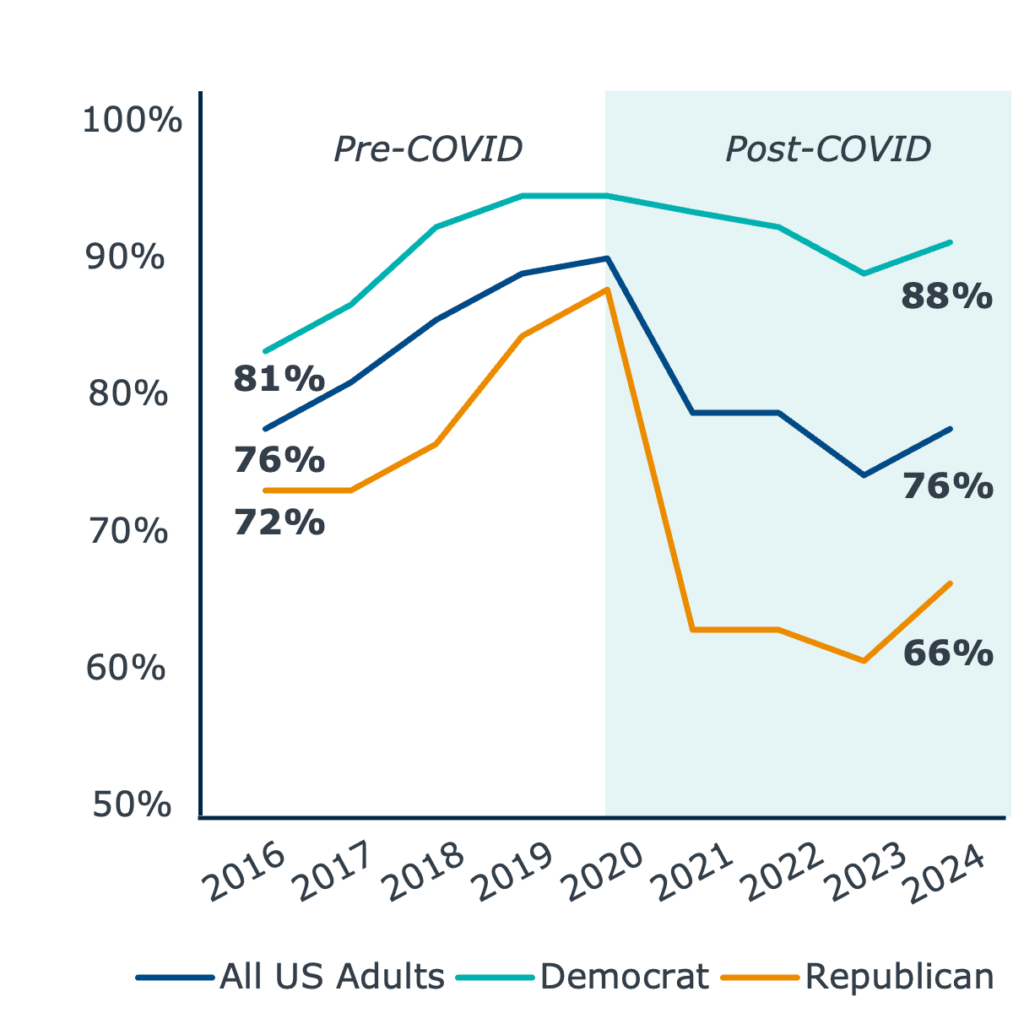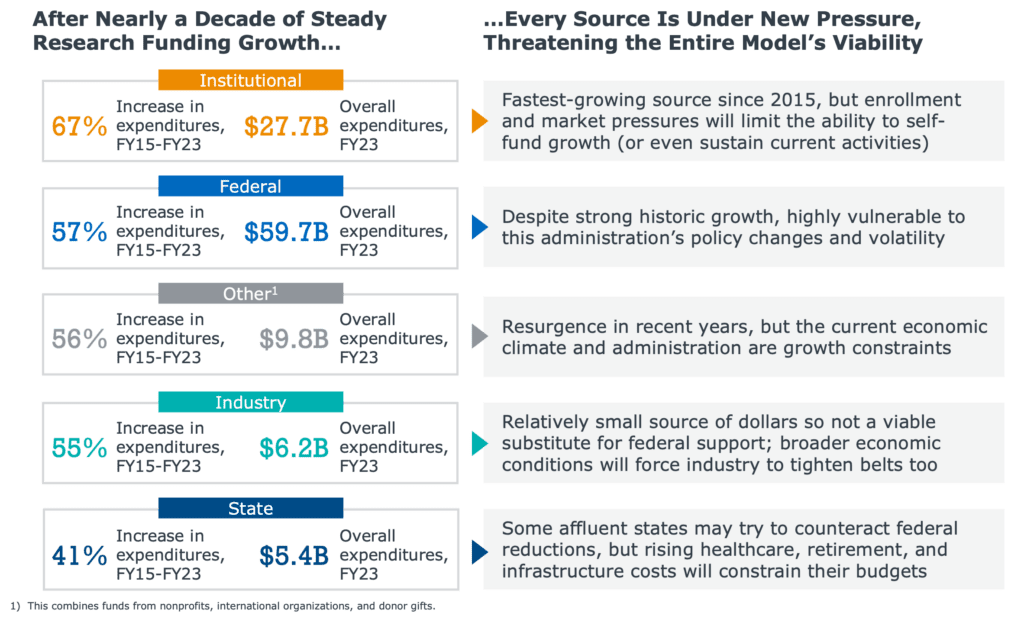University research is at a crossroads. Here are three key questions academic leaders must answer.
Earlier this spring, EAB hosted a two-day roundtable bringing together provosts and chief research officers to discuss evolving political, market, and financial pressures reshaping higher education’s academic foundations. A common theme emerged: how to ensure the research enterprise remains resilient and relevant in a shifting policy landscape. Read on for three pressing questions that academic leaders need to address as they plan for the future of university research.
1. How can we make research matter to the public again?
There has been a lot of focus on the crisis of public confidence in higher ed. But far less attention has been given to public confidence in science despite a major COVID-19-induced decline that is only now beginning to rebound. Federal funding cuts and threats to facilities and administrative (F&A) support are only increasing the urgency for academic leaders to explain and defend the value of university research daily.
Public confidence in scientists is just starting to rebound from the big COVID-19-induced decline
Percentage of Americans who have a great deal or a fair amount of confidence in scientists to act in the best interests of the public

Yet, many leaders struggle to distill complex or unfamiliar concepts into a digestible narrative that resonates with the broader public—or even internal stakeholders like faculty and boards. For example, attendees shared that the proposed NIH cap on facilities and administrative (F&A) costs revealed varying levels of understanding across the institution about F&A’s utilization and impact, leading to inconsistent messaging and, in some cases, perpetuating myths and skepticism.
As a result, many chief research officers are investing in internal presentations focused on debunking common myths about F&A and explaining campus-specific F&A policies. This ensures that internal stakeholders have an accurate understanding and are presenting a unified front when engaging with external constituencies, especially policymakers.
-
Educate stakeholders on F&A funding
Explore our toolkit for five tools to better communicate about F&A with stakeholder groups.
Chief research officers also emphasized that state legislators are an increasingly important audience to focus on since they, too, are looking to reduce funding amid budgetary pressures. However, many of our roundtable attendees spoke openly about their hesitation to engage with moderate or conservative state legislators, given the trend of heightened political oversight under the Trump administration.
Aware that local advocacy may be the best path forward, a few shared their seemingly simple communication strategy: make it ultra-personal. Academic leaders can use targeted campaigns to tailor messaging to local policymakers or partners—for example, highlighting how the university’s research stimulated the regional economy or drawing on testimonials from local industry leaders and influential community members about the real-world impact of research.
-
Tell the story of research
Read our research report for 13 tactics to support and improve research communications.
Of course, improved communications and storytelling will only get institutions so far. To truly prove research’s relevance and demonstrate value to the public, they must also continuously ensure that their research activities are aligned with public priorities and help solve real-world problems in their regions and communities.
2. How can we forge smarter partnerships to make research more sustainable?
Given threats to federal research funding, academic leaders are increasingly questioning the financial sustainability of their research portfolio and grappling with growth expectations. Institutional self-funding now surpasses all other funding sources, but downward enrollment pressures threaten this model since there is less tuition revenue available to support subsidies. Academic leaders must therefore prioritize where to invest limited institutional dollars and explore new partnerships, focus areas, and funding sources.
Federal policy changes exacerbate portfolio risks

One place many academic leaders are looking for more financial support is industry. Employers offer a potential avenue for diversifying funding and demonstrating relevance. Plus, their focus on speed, relevance, and practical impact is particularly attractive in the current policy landscape. However, industry partnerships are rarely a direct replacement for federal grants that support basic research. Industry partners tend to focus more on applied research and are more concerned with faster, commercial output that directly relates to market needs.
So while academic leaders should invest in forging new partnerships with regional employers and supporting faculty in doing more industry-relevant research, that alone will not be sufficient for long-term enterprise sustainability. Leaders will have to continue to explore a broader array of cross-sector partnership types and identify opportunities to scale back their research costs.
-
Explore a modern anchor institution in action
Read our case study of Wichita State University (WSU), an exemplar modern anchor institution that bases strategy not on internal interests, but on the priorities of external stakeholders and the needs of their region.
3. How can we rightsize our portfolio for lasting relevance and impact?
With a potential F&A cap looming, it is hard not to imagine a future where the research enterprise experiences significant cuts. As a result, many institutions will struggle to sustain their current research portfolios.
In candid moments, several chief research officers admitted that their current strategies are primarily defensive and grounded in surviving the next three years of the Trump administration. But by focusing solely on rebuffing cuts and trying to preserve the research model that they have always known, leaders are missing an opportunity for longer-term planning and strategy innovation.
The savviest institutions will instead seize this moment to redefine and rightsize their research portfolio, clearly tying it to existing institutional strengths in regional and community-aligned areas. With financial sustainability and institutional mission at the forefront, academic leaders should facilitate a cabinet-wide evaluation of research priorities with the goal of pinpointing areas to double down on as well as areas to potentially discontinue or pivot to better align with funding realities and public needs.
-
Request a resilient future planning workshop
EAB’s facilitated workshops for cabinets help institutions navigate critical uncertainties in the federal policy landscape.

More Blogs

Responding to federal policy shocks: What we learned from nearly 50 higher ed institutions

What recent federal policy changes could mean for community colleges
